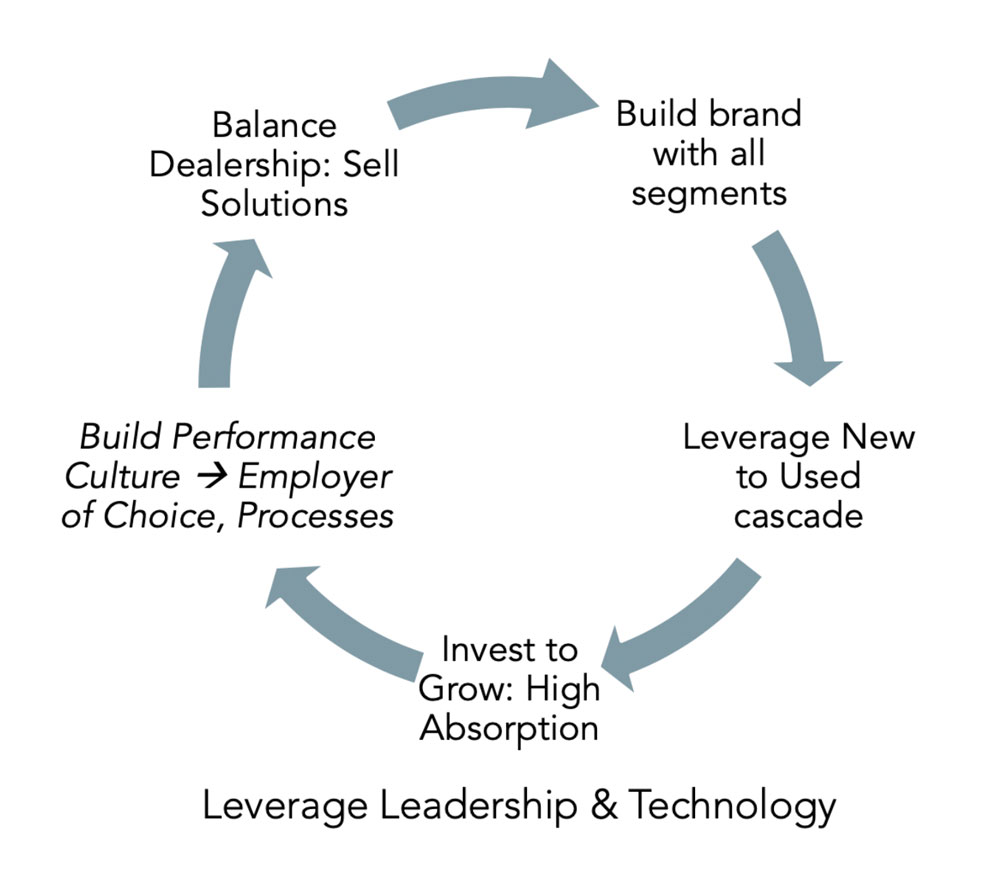Absorption is simple to calculate, but to understand its “Good to Great” power in a dealership is complicated.
Absorption is both a defensive and offensive strategy, and, although it is a financial metric that contributes to a high return on assets (one of two goals of a dealership), better absorption also contributes to creating repeat customers (the second main goal).
This second spoke in the Good to Great Sustainable Dealership Flywheel follows directly from the first, which we examined last month in ‘Leveraging the New to Used Cascade.”
Drivers of Absorption
Calculating absorption is simple — Gross Profits from Service and Parts divided into Total Expenses of the dealership. And so there are 3 drivers of absorption.
To increase gross profits, a dealership can either do the right things to sell more labor or parts (Driver #1), or to sell the same but at a higher margin (Driver #2), or both. Expenses are Driver #3 and cost control is often the single biggest difference between dealers with low or high absorption. A Good to Great Dealership manages expenses well.
Some OEMs or consultants, including me, reduce the expense component by subtracting the people related expenses of the wholegoods sales department, thus making full (or 100%) absorption easier to achieve (typically about 12-15 points easier). Also gross profits from rental (if you do that) are also part of the absorption calculation because, like service and parts, rental is a more recurring business.
Absorption for Defense: Sustainability in Downturns
The cyclicality of farm equipment wholegoods demand is what began the concept of absorption.
The experience is that the service, parts and rental business is more stable than wholegoods because it is more recurring — the farmer or contractor is still working with the machines and they still need to be repaired or maintained.
The word absorption is used because the gross profits from recurring revenue should “absorb” the expenses of the dealership when the more variable wholegoods business is in a cyclical industry downtown.
At the extreme, absorption allows a dealership to keep the lights on when machines are not selling. That’s defense.
Absorption for Offense: Create Capital to Grow
High absorption is a key part of a dealership’s strategy for growth. With high absorption, the financial benefit of higher net profit funds investments for growth. Higher net profits results from both more gross profits from service and parts and lower expenses. The service and parts departments should have the highest net profit percentages so improvements there affect the bottom line and the balance sheet. The increase in retained earnings from high absorption will most quickly improve debt to equity ratios.
And don’t forget the importance of expense control — “A penny saved is a penny earned!”
So, more highly absorbed dealers tend to have more capital to grow. That’s offense.
High Absorption Creates Repeat Customers
To achieve high absorption, dealers must have good processes and good attention to detail.
This type of ‘Good to Great’ dealership culture yields a financial return and it also tends to result in better customer service and satisfaction. Here are couple examples.
Faster and more efficient closing of work orders usually means better communication with customers during and after the repairs.
Better parts inventory ordering and management usually means greater breadth and a greater likelihood to have the right parts in stock.
Absorption helps create repeat customers and high return on assets.
Next month we’ll explain the third spoke of the Good to Great Flywheel titled ‘Build a Performance Culture: Be the Employer of Choice, Leverage Vital Processes.’







